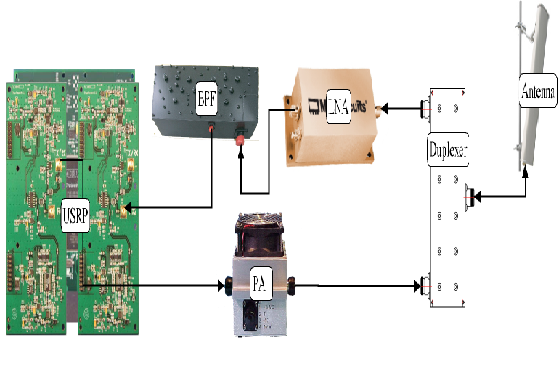Eng.karim Salih is now not available try anather time
Its my project
Burning Man 2009 RF Chains
We have legal clearance for operation in 870-880 MHz downlink, 825-835 MHz uplink.
RF Paths
We start by planning the uplink (receive) path. Here are the core facts:
- The typical handset has a maximum output of 30 dBm on what is roughly a 0 dBi antenna.
- The thermal noise level of the GSM channel is about -120 dBm.
- We want a minimum Ec/No of 8 dB, which is standard for GSM systems (GSM 03.30), giving a residual BER of 0.2%, meaning that the signal level would need to be -112 dBm in an ideal receiver.
- We assume a mast height of 50 ft (~15 m).
RX Path
antenna -> long cable -> duplexer -> LNA1 -> BPF -> USRP
Comments on components:
- The USRP is believed to have a noise figure of about 8 dB.
- The best cable we can reasonably afford is LMR-400, 0.13 dB/m @ 900 MHz. The cable will be about 15 m long, for a loss of 2 dB (rounding).
- The insertion loss on the duplexer is 1 dB, worst case.
- A decent LNA has a noise figure of 1 dB or less.
- We can expect to get a gain of about 10 dB in the antenna.
LNA1 is outside the USRP to help overcome any noise or crosstalk inside the USRP case. We need a phone at the edge of the service radius to produce -112 dBm at that LNA1 input. The path from the handset to the LNA1 is
30 dBm -P +10 -2 -1 -1 = 36 dBm -P = -112 dBm
where P is the path loss. Rearrange for
P = 112 + 36 = 148 dB.
So we can tolerate a path loss of 148 dB and we are working from a 15 m tower at 830 MHz. According to the Hata model, that corresponds to a range of 5.0 km (3.1 mi) for suburban service and 15.8 km (9.8 mi) for open rural service. Black Rock City is about 3.8 km wide and the distance from center camp to the highway is 8-10 km, so this system will meet the goals of providing solid coverage over BRC and much of the "deep Playa" and providing service over the last few miles of highway approaching the turn to the front gate.
How much LNA gain do we need? The D/A on the USRP has a range of 2 v p-p (10 dBm on 50 Ohms) and the bottom 5% of that range (-16 dBm on 50 Ohms) is occupied by noise at maximum gain. So to match our thermal noise of -120 dBm to the USRP's noise floor of -16 dBm, we need a total gain of 104 dB. The USRP already has an internal gain of up to 81 dB, so we need 23 dB of gain from LNA1. LNA1 also allows us to tolerate insertion loss in the BPF without a loss of receiver performance.
TX Path
USRP -> PA -> duplexer -> long cable -> antenna
Our ERP is limited to 20 W (43 dBm) by our license. Since the handset is transmitting 1 W, downlink range isn't going to be an issue. The point of the transmit path analysis is to determine the specifications for PA. The path gain from the PA to the antenna is:
T -1 -2 +10 = T +7 = 43 dBm
where T is the transmit power, so T is 36 dBm maximum, or 4 Watts. In a 2-ARFCN system, that will be 2 W/ARFCN, or 10 W EIRP/ARFCN, which is plenty of downlink power for this system.
The output of the USRP is about 20 dBm, so we need a gain of about 16 dBm in the PA.
In summary, our ideal PA is 36 dBm output, 16 dB gain. We can use PAs with slightly higher power or higher gain by scaling back the USRP output or using an attenuator.
RX/TX Isolation
These aspects of the design determine the required degree of rx/tx isolation:
- Receiver levels at the USRP. We are pushing 36 dBm into the same cable that is bringing in our -112 dBm signal. We need to push that 36 dBm down to the thermal noise level of -120 dBm by the time it hits the USRP. So we need an isolation of 120 + 36 = 156 dB between these paths at the USRP.
- LAN compression. LNA1 will start to compress at an output of 24 dBm. The gain is 32 dB, so LNA1 will start to compress for an input of -8 dBm. So the duplexer must push the 39 dBm PA output down below -8 dBm to avoid compression. So we need at least 47 dB of isolation in the duplexer to avoid compression.
- RX-band noise in USRP TX output. The USRP outputs noise in the receive band about 80 dB below the transmit signal level, or around -60 dBm. The duplexer needs to be able to suppress that noise down to -120 dBm or lower to prevent degradation of the receiver. So we need at least 60 dB of isolation in the duplexer to limit that noise.
So we need a total of 156 dB of transmitted signal suppression from the duplexer and BPF together. We need at least 60 dB of that to come from the duplexer.
Component Specifications
LNA
We are planning to use the Mini-Circuits ZRL-1150LN. It is readily available and is very reasonably priced, given its specifications:
- 685-1000 MHz
- 31 dB gain
- 1 dB compression at 24 dBm
- <1 dB noise figure
- +10 - +17 VDC supply
- $120
PA
Because we are operating under an experimental license in GMS850, we can use modified or de-rated 33 cm amateur equipment, which will save a considerable amount of money. The Downeast Microwave 3340PA is a good candidate:
- 30 dB gain
- 46 dB IP1 output
- 13.5 VCD supply
- $235
The 3340PA will require a 15 VCD Zener diode on its power supply terminals to protect from over-voltage damage. We will need a 10-15 dB attenuator to match the output level of the RFX900 to the expected input level of the PA.
Duplexer
The candidate duplexer is the Anatech Microwave AD836-881D200:
- 824-849 MHz, 869-894 MHz
- 70 dB isolation
- <1 dB insertion loss
- $360
Bandpass Filter (BPF)
The candidate BPF is the Aantech Microwave AB832B477:
- passband 824-840 MHz
- 95 dB suppression at 869 MHz
- <1 dB insertion loss
- $325
With the 70 dB duplexer, this BPF will give a total tx-rx isolation of 165 dB, beating our requirement by 9 dB.
Antenna
The candidate antenna is the Hyperlink HG913P-120:
- 860-960 MHz (should work well enough at 825 MHz, though)
- 13 dBi (de-rate to 10 dBi for 825 MHz, worst case)
- 120-deg x 15-deg beam
- $200
The additional 3 dB of antenna gain may add 40% to the coverage range.
 |
 |
Number of vistors:-


